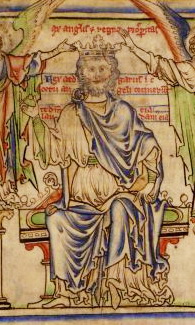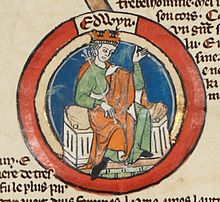(d.c685)
King of Wessex
676-685.
His lover was:
Eangyth (c660-after 718)
Anglo-Saxon aristocrat & nun.
Natural offspring:
1. Edburga (c680-?)
"Eangyth was of noble birth and during her youth the mistress of Centwine, King of Wessex (676 – 685) to whom she bore a natural daughter Edburga (Bucge) (c680). Eangyth took holy orders and was placed as abbess of the convent at Minster on the island of Sheppey in Kent, where she raised their daughter. Mother and daughter were on friendly terms with St Boniface, with whom they corresponded. A surviving letter (dated c716 – 718) is written by Eangyth and her daughter jointly, and in it they apologise for writing ‘in rustic style and unpolished language.’ The abbess also speaks of problems facing the religious community, and mentions the desire of both ladies to make a pilgrimage to Rome. Eangyth died before this could be accomplished, though her daughter later travelled there." (A Bit of History)
 |
| Edgar of England |
Edgar I of England (943-975)
King of England 969
Son of: Edmund the Elder & Saint Aelfgifu of Shaftesbury.
Husband of:
1) Aethelflaed of Devon, mar 963
2) Aelfthryth of Devon, mar 965.
"Edgar the Peaceful married twice, his first wife, Elfleda was divorced to enable him to marry Elfrida, daughter of Ordgar, ealdorman of Devon and Edgar's mistress, she was the widow of Ethelwald, Ealdorman of East Anglia and a woman of notorious reputation. She was said to have been the King's lover before the death of her first husband." (English Monarchs)
Edgar's physical appearance & personal qualities.
Edgar's physical appearance & personal qualities.
"In common with his brother Edwy and others of his predecessors in the House of Wessex, Edgar was a very small man, recorded as being less than five feet tall, although possessing great personal magnetism. The Anglo-Saxon Chronicledescribes him as being handsome and speaks highly of his achievements." (English Monarchs)
His lover was:
Wulfthryth, Abbess of Wilton (945-1000)
No saintly morals.
"The monkish writers, with whom Edgar is such a favourite, have not altogether concealed the fact that he was no saint in his morals. Even Lingard seems to admit that one story is tolerably well authenticated, which attributes to him the violation of a lady of noble birth, and that too while she was resident in a convent. Another is told of his having, on one occasion, ordered one of his nobles, whose guest he was, to give him his daughter for a bedfellow, and of the young lady;s honour having been saved by her mother substituting for her a handsome slave, with whom the king was so pleased that, after discovering the deception, he took her to court and retained her for some ears as his favourite mistress...." (Long, Vol. 9: 271)
"Edgar had many mistresses, one of these was the beautiful Wulfrida, whom he carried off from Wilton Abbey, it is unsure if she had actually taken her vows as a nun. For this the King was forced to do penance for seven years, purportedly having to fast twice a week. He had 4 children in all, by his first wife Ethelflaed, he had two sons, the eldest Edward, succeeded him as King of England, and Edmund. An illegitimate daughter, Edith or Eadgyth, born to by Wilfrida, was educated at Wilton Abbey and was canonised after her death in 984. A third son, born to Queen Elfthryth succeeded his half-brother Edward as Ethelred II." (English Monarchs)
" . . . His short reign was fraught with scandal and crisis. Edwig was a troublesome youth, and led a dissolute life. He was early seduced and had become besotted on a widow, Ethelgive, who was twice his age, and resolved to cover their connection by marrying her daughter Elgive. After his coronation Edwig openly lived with the two women at once, which caused an enormous scandal that brought him into conflict with the Arch-Bishop Oda. The affair shook the nation. It became public knowledge on the very day of his coronation. That evening, during the coronation-banquet, the king quietly slipped-off with his mistress and her daughter. The Arch-Bishop, Oda, noticing the king's absence, sent two clerics, to enquire after the king and remind him of his duties requesting his return to the banquet. To their horror, they found the king and his mistress, and her daughter, in the king's chamber, all three on a sofa with their clothes disheveled engaged in sordid behavior. The clerics physically separated the king from the two women, dragging the king from their arms, and forced him to return to the banquet. The assembled nobles and clerics at the banquet were dumbfounded with shock and dismay by the actions of the two clerics, and even more appalled by the lack of the king's sense of decorum. The next year, in 957, Edwig married the daughter of his mistress, Elgive, whose father, Ethelred, Earl of Wessex, had been a relative of the royal family. . ." (Hugues. The British Chronicles, Vol. 1: 291)
"Edgar had many mistresses, one of these was the beautiful Wulfrida, whom he carried off from Wilton Abbey, it is unsure if she had actually taken her vows as a nun. For this the King was forced to do penance for seven years, purportedly having to fast twice a week. He had 4 children in all, by his first wife Ethelflaed, he had two sons, the eldest Edward, succeeded him as King of England, and Edmund. An illegitimate daughter, Edith or Eadgyth, born to by Wilfrida, was educated at Wilton Abbey and was canonised after her death in 984. A third son, born to Queen Elfthryth succeeded his half-brother Edward as Ethelred II." (English Monarchs)
 |
| Edwy I of England the All-Fair @Wikipedia |
(950-959)
King of the English
955-959
Husband of Aelfgifu, ann 958
" . . . [H]e rendered himself contemptible, by the immorality of his private life. Ardent in the pursuit of pleasure, and regardless of public decency, he abandoned himself to the most unseemly enjoyments. The language in which our ancient writers uniformly describe and reprobate this part of his conduct, is not fir for the eye of every reader; but it will be proper to delineate the real nature of his connexion with Ethelgiva, a subject, which, though unimportant in itself, has derived som interest from the embellishments with which it has been adorned by the fancy of modern historians." (Lingard. A History of England, Vol 1: 200)
His lover was:
"Ethelgiva was a lady of noble birth, who had conceived the design of securing the dignity of queen for herself or for her daughter. With the view of captivating Edwy's affections, the one of the other was constantly in his company; and, if we may credit the scandal of the age, neither of them hesitated to sacrifice her honour to the hope of obtaining the object of her ambition. . . ." (Lingard. A History of England, Vol 1: 200)
Affair's end & aftermath.
"Soon after this transaction Edwy appears to have married, an event which might have been expected to put an end to the connexion between him and his mistress. Whether on that occasion Ethelgiva was committed to the care of her relations or of her husband, we are ignorant; but he king, either instigated by his passion, or moved by her solicitations carried her off by force, and placed her in one of the royal farms. Archbishop Odo undertook to remove the scandal by enforcing the punishment, which the laws awarded against women living in a state of concubinage. Accompanied by his retainers, he rode to the place, arrested Ethelgiva, probably in the absence of her lover, conducted her to the sea-side, and put her on board a ship, in which she was conveyed to Ireland. At his return to court, he waited on Edwy, and in respectful and affectionate language endeavoured to justify his own conduct, and to sooth the exasperated mind of the young prince. X X X Ethelgiva, who had returned from Ireland, was the companion of his flight. At Gloster she fell into the hands of the pursuers, who with their swords divided the sinews of her legs, a cruel but not unusual mode of punishment in the age. After lingering in great torment for a few days, she expired." (Lingard. A History of England, Vol 1: 200)
Gunhild Haroldsdotter of England (1061-1095)
Her lovers were:
1) Alain Niger de Bretagne, Lord of Richmond.
2) Alain Rufus de Bretagne, Lord of Richmond.
2) Alain Rufus de Bretagne, Lord of Richmond.
" . . . She became a nun, but left her convent to live with the count of Brittany as his mistress. . . ." (abitofhistory.com) [Ref1]
His lover was:
Edith Swan's Neck (1025-1086)
"Less obscure, and even more tragic, was the story of Eadgyth Swanneheshals, or Edith of the Swan-neck, who was the concubine of Harold Godwinson, Duke of Wessex, later King Harold II. Whilst Harold was Earl of Wessex she lived happily with him, having at least six children, once of whom, Gytha, married Waldemar, King of Novgorod (now in Russia), while another became a nun closer to home at Wilton. . . ." (Carlton: 10)
"She it was who is said to have identified his body after the battle of Hastings. Nothing more than this is known about her." (Pulling: 405)
" . . .Harold Godwinson, the last king of Anglo-Saxon England, only repudiated his charmingly named mistress, Edith Swan's Neck, after he seized the the throne in 1066, in order to gain the support of the northern earls Edwin and Morcar by marrying their sister (also called Edith). . . ." (Given-Wilson and Curteis: 21)
" . . .Harold Godwinson, the last king of Anglo-Saxon England, only repudiated his charmingly named mistress, Edith Swan's Neck, after he seized the the throne in 1066, in order to gain the support of the northern earls Edwin and Morcar by marrying their sister (also called Edith). . . ." (Given-Wilson and Curteis: 21)
No comments:
Post a Comment